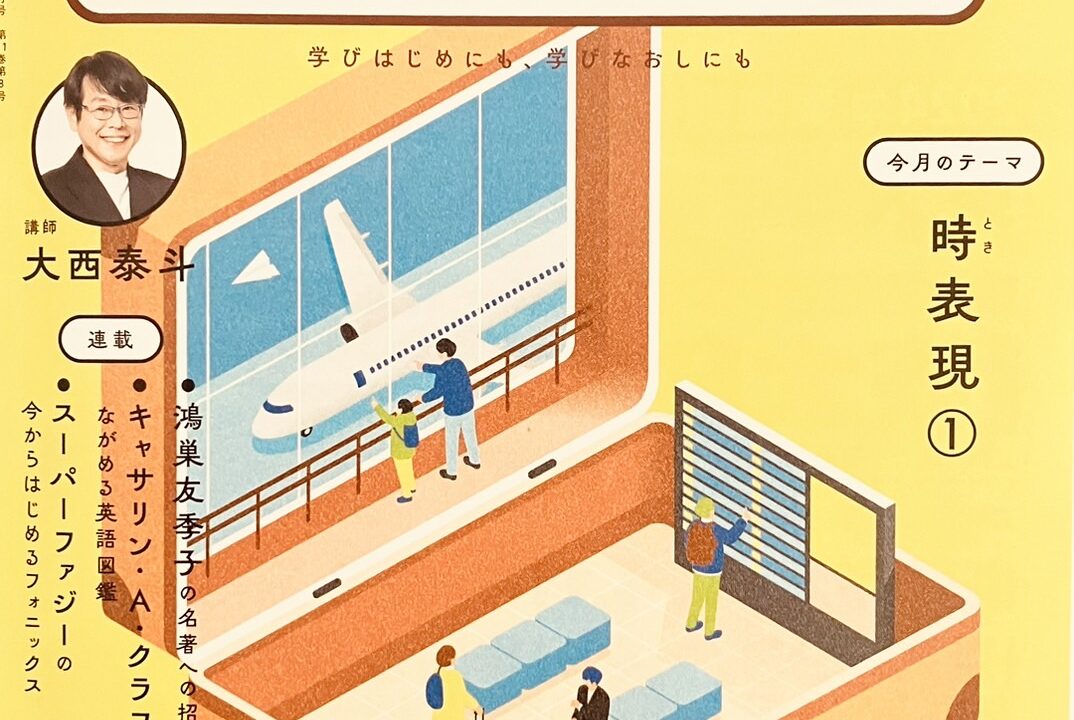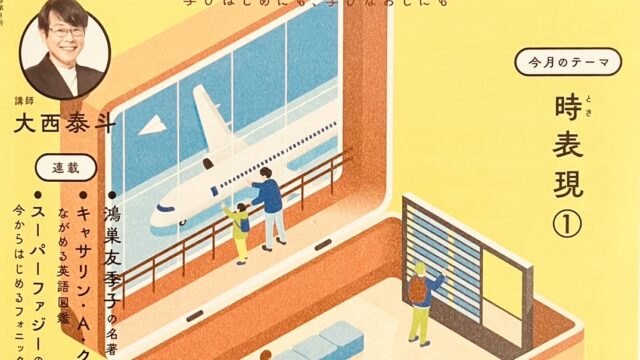【ラジオ英会話】Lesson 158 現在完了形②過去の出来事を今に引きつける(継続用法) – November 27 Wednesday, 2024

November 27 Wednesday, 2024
Lesson 158 現在完了形②過去の出来事を今に引きつける(継続用法)
☆Words & Phrases
**go to bed:
**rather:
Grandpa, aren’t you going to bed? – Yes, it is rather late.
That would be boring for you, Roxy.
**birthplace:
Shakespeare’s birthplace? Yes, we went there together a few years ago.
**suppose (that) ~:
**probably:
Then I suppose Christmas at home is probably the best thing.
Sounds wonderful, Grandpa.
☆Grammar and Vocabulary
I’ve been thinking about where to spend our winter holidays.
現在完了進行形
現在完了進行形(have been+動詞-ing形)が使われている
この形は「(今に)迫ってくる」現在完了形と、生き生きとした行為を描写する進行形のハイブリッド。過去から現在に向けて「ずっと〜している」と、行為が繰り返されていることが表されている
この文は、過去から現在に向けて thinking, thinking, thinking… してきたということ
Then I suppose Christmas at home is probably the best thing.
then のイメージ「視線を移す」
ここでは相手の意見を受け「それなら」と、自説に視線を移している
then は「そのとき」「それから」と訳されることもあるが、それぞれ「過去や現在に視線を移す」「出来事に順々に視線を移す」というケースで生まれている訳である

☆Target Forms
You’ve been to Stratford-upon-Avon, haven’t you?
現在完了形が「経験」を表している。「経験」を述べる際、私たちは過去の出来事を今に引きつけて語る。なので「(今に)迫ってくる」現在完了形は「経験」を述べるのにピッタリ
この文で have been が「行ったことがある」と訳されているが、be動詞は通常の「=(イコール)」である。場所を to で指し示し「ここにいたことがある」。それを日本語訳の都合で「行った」と訳しているだけ
Practice
過去の出来事を、現在の経験として引きつけて語りましょう。
You’ve been to Stratford-upon-Avon, haven’t you?
① Have you ever been there?
Have you been there before?
→ ever と before は「経験」によく使われる単語
ever は at any time(いつの時点であっても)で、特定の時点に限らない経験を尋ねている。「いつのことでもいいの ですが、〜したことはありますか?」ということ
② I’ve never climbed Mt. Fuji.
→ never は「一度も~したことがない」と「経験」の否定で使われる
never は「どの時点であっても~ない」で、ever の逆
③ Ever been there? – No. Never been there.
→「行った経験」について述べるカジュアルな言い回し
★Practice
D: Okay everyone. Today’s「現在完了形」is about “experience”. Experiences are like trophies. The action is complete but you have the trophy now on a shelf, on display. So let’s practice those together.
R: Ready to practice guys? Repeat after us,
– Have you ever been there?
Another one,
– Have you been there before?
D: Great work. Let’s keep going,
– I’ve never climbed Mt. Fuji.
R: And one more, which is a conversation. Practice both parts,
– Ever been there? – No. Never been there.
Once more,
– Ever been there? – No. Never been there.
D: Unlock your potential.
R: Repetition is the key!
D&R: Great work.
☆Grammar in Action
①ペットを所有したことがありますか?そう見えるほど簡単じゃありません。
②私はひっぱりうどんを食べたことがありませんが、とってもおいしいと聞いています。
③そこに行ったことがありますか?今度の長い週末に行くことを考えているのです。
★Ending
O: Hey David. How did you hear about ひっぱりうどん?
D: Oh, I’ve heard about it from different videos and travel diaries. It looks pretty interesting. Have you ever tried it?
O: No. Have you, Roza?
R: No, but if it’s so popular, probably it’s like ひっぱりだこ.
November 27 Wednesday, 2024
Lesson 158 現在完了形②過去の出来事を今に引きつける(継続用法)
(日本語訳・解説付き)
☆Words & Phrases
**go to bed: 寝る
**rather: かなり
Grandpa, aren’t you going to bed? – Yes, it is rather late.
おじいさん、まだ寝ないの? – そうだね、ずいぶん夜も更けたし。
※go to bed の bed は不可算名詞です。ここでは、1台、2台と数えられるベッドそのものを表しているのではなく、「寝る」という意味で使われているため不可算となります
That would be boring for you, Roxy.
それだとお前は退屈だろう、ロキシー。
※That would be ~ は条件を織り込んだ表現。つまり「(家にいるだけ)だったら退屈だろう」ですね!
**birthplace: 生誕地
Shakespeare’s birthplace? Yes, we went there together a few years ago.
シェークスピアの生誕地よね?ええ、私たち、何年か前にそこに一緒に行ったわ。
**suppose (that) ~: ~だと推定する
**probably: たぶん、おそらく
Then I suppose Christmas at home is probably the best thing.
だったら、たぶん、家で過ごすクリスマスがいちばんいいのかも しれないな。
Sounds wonderful, Grandpa.
それがいいと思うわ、おじいさん。
※Sounds wonderful. は説明型オーバーラッピング(SVC)の形です。主語は省略されています
☆Grammar and Vocabulary
I’ve been thinking about where to spend our winter holidays.
私は、私たちの冬休みをどこで過ごそうかと考えています。
現在完了進行形
現在完了進行形(have been + 動詞-ing形)が使われている
この形は「(今に)迫ってくる」現在完了形と、生き生きとした行為を描写する進行形のハイブリッド。過去から現在に向けて「ずっと〜している」と、行為が繰り返されていることが表されている
この文は、過去から現在に向けて thinking, thinking, thinking… してきたということ
Then I suppose Christmas at home is probably the best thing.
それなら、たぶん、家でのクリスマスがいちばんいいのでしょう。
then のイメージ「視線を移す」
ここでは相手の意見を受け「それなら」と、自説に視線を移している
then は「そのとき」「それから」と訳されることもあるが、それぞれ「過去や現在に視線を移す」「出来事に順々に視線を移す」というケースで生まれている訳である

☆Target Forms
You’ve been to Stratford-upon-Avon, haven’t you?
あなたは、ストラトフォード=アポン=エイボンに行ったことがありますよね?
現在完了形が「経験」を表している。「経験」を述べる際、私たちは過去の出来事を今に引きつけて語る。なので「(今に)迫ってくる」現在完了形は「経験」を述べるのにピッタリ
この文で have been が「行ったことがある」と訳されているが、be動詞は通常の「=(イコール)」である。場所を to で指し示し「ここにいたことがある」。それを日本語訳の都合で「行った」と訳しているだけ
Practice
過去の出来事を、現在の経験として引きつけて語りましょう。
You’ve been to Stratford-upon-Avon, haven’t you?
① Have you ever been there?
あなたはそこに行ったことがありますか?
Have you been there before?
あなたは以前そこに行ったことがありますか?
→ ever と before は「経験」によく使われる単語
ever は at any time(いつの時点であっても)で、特定の時点に限らない経験を尋ねている。「いつのことでもいいの ですが、〜したことはありますか?」ということ
② I’ve never climbed Mt. Fuji.
私は富士山に登ったことがありません。
→ never は「一度も~したことがない」と「経験」の否定で使われる
never は「どの時点であっても~ない」で、ever の逆
③ Ever been there? – No. Never been there.
そこに行ったことある? – いや。行ったことないよ。
→「行った経験」について述べるカジュアルな言い回し
★Practice
D: Okay everyone. Today’s「現在完了形」is about “experience”. Experiences are like trophies. The action is complete but you have the trophy now on a shelf, on display. So let’s practice those together.
R: Ready to practice guys? Repeat after us,
– Have you ever been there?
Another one,
– Have you been there before?
D: Great work. Let’s keep going,
– I’ve never climbed Mt. Fuji.
R: And one more, which is a conversation. Practice both parts,
– Ever been there? – No. Never been there.
Once more,
– Ever been there? – No. Never been there.
D: Unlock your potential.
R: Repetition is the key!
D&R: Great work.
☆Grammar in Action
①ペットを所有したことがありますか?そう見えるほど簡単じゃありません。
Have you ever owned a pet? It’s not as easy as it seems.
②私はひっぱりうどんを食べたことがありませんが、とってもおいしいと聞いています。
I’ve never eaten hippari udon, but I hear it’s really good.
③そこに行ったことがありますか?今度の長い週末に行くことを考えているのです。
Ever been there? I’m thinking of going for the upcoming long weekend.
※think が進行形で使われていることに注意!「考えている」という積極的な行為
★Ending
O: Hey David. How did you hear about ひっぱりうどん?
ねえ、デイビッド。どうやって「ひっぱりうどん」のことを知ったの?
D: Oh, I’ve heard about it from different videos and travel diaries. It looks pretty interesting. Have you ever tried it?
えっと、いろんな動画とか旅行記で見たんだ。面白そうだよね。食べたことある?
O: No. Have you, Roza?
いや、ないよ。ローザは?
R: No, but if it’s so popular, probably it’s like ひっぱりだこ.
私もないけど、そんなに人気なら「ひっぱりだこ」なんじゃない?
名古屋駅前【AI×英会話】名古屋BEGビジネス英会話ジム – AIで鍛えるビジネスで使える英語力。仕事も日常も、一歩先へ。
営業時間:平日 9:00~22:00 土曜日 9:00~19:00(日祝休み)
〒450-0002 愛知県名古屋市中村区名駅2丁目40-16 名駅野村ビル 5階




